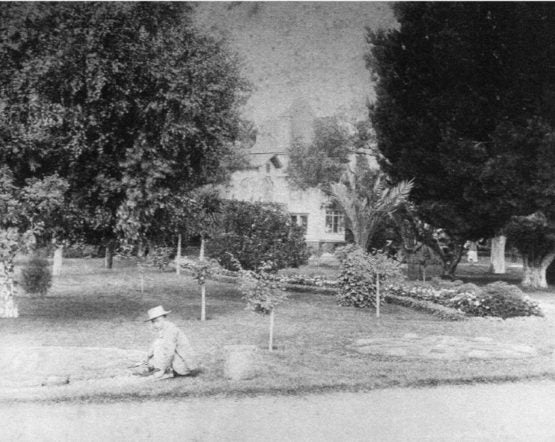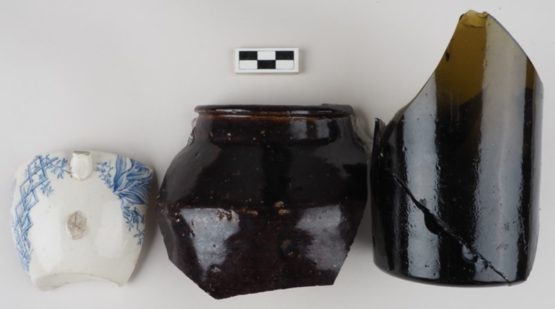Uncovering the lives of Chinese workers who built Stanford
In a new spring course, students are excavating the location of the former living quarters of Chinese workers who helped build Stanford.
In 2017, archaeologists with Stanford Heritage Services conducted archaeological testing at a site in the Stanford Arboretum. The research confirmed that Chinese laborers who helped build the Stanford campus had once lived there. Now, a new spring archaeology course seeks to tell the stories of those forgotten workers by unearthing where their living quarters stood.
“We really want to know what the lived experience was for these workers because, even now, so many refer to these laborers as workers, which defines them by the work that they did and does not speak to their broader lives,” said Megan Victor, a postdoctoral scholar in the Stanford Archaeological Center who is co-teaching the course Archaeological Field Methods with university archaeologist Laura Jones. “But these were people with complex and complete lives, so looking at a place where they lived really allows us to get a better glimpse into what their lives might have been like.”

A Chinese gardener working on the grounds of the Stanfords’ Palo Alto residence. (Image credit: Courtesy Stanford University Digital Archives)
The role that Chinese laborers played in the construction of Stanford University can’t be overstated. Even before the establishment of the university, Leland Stanford employed Chinese migrants to maintain and operate his Palo Alto Stock Farm, raise and train his horses, work in vineyards and wineries, and tend to the orchards and gardens. They would later help build some of the most iconic features of Stanford, including the Oval and Lake Lagunita. They also planted every palm tree on Palm Drive. However, there has not yet been any archival evidence found that suggests these Chinese migrants worked on the construction of the First Transcontinental Railroad, which was overseen by the so-called “Big Four,” who included Leland Stanford.
Beginning in the 1870s, anti-Chinese discrimination spread rapidly across the western United States. Victor said that, as a result, many wealthy employers began housing their Chinese workers on their property. “You see this especially after the Chinese Exclusion Act in 1882, where people are trying to protect the Chinese workers that they have,” Victor said. “And Leland Stanford did this, too.”
Stanford archaeologists estimate that there were between four and six residences on the Palo Alto Stock Farm – and later the university – where Chinese workers lived.

“These were people with complex and complete lives, so looking at a place where they lived really allows us to get a better glimpse into what their lives might have been like.”
—Megan Victor
Postdoctoral Scholar, Stanford Archaeological Center
One of those sites was identified by the university’s archaeologists. The process involved georeferencing historic maps of the site with the present-day landscape, then stretching a 5-meter by 5-meter grid over the area that the maps indicated as most likely to have contained the workers’ quarters. The archaeologists then conducted test excavations at the intersections along the grid as a pilot project to verify whether there was any archaeological evidence of the quarters that the historic maps said should be there. During the first pilot excavation in 2017, the archaeologists found a kitchen midden containing broken pieces of cups and plates, as well as animal bones from cooked meals. Today the site is known among Stanford archaeologists as the Arboretum Chinese Labor Quarters, and was likely occupied by Chinese workers from the early 1880s until 1925.
Leland and Jane Stanford kept meticulous notes about the day-to-day operations of the Palo Alto Stock Farm and the early days of the university. Documentation shows that Chinese workers had a variety of jobs and the potential for upward mobility, and were also paid the same as white workers. However, little is known about the personal lives and identities of these Chinese employees. Victor hopes that research conducted by students in Archaeological Field Methods, and later continued by Victor and Heritage Services during summer excavations, will provide some clues.
“In particular, we are interested in what they were doing when they were not working, where they ate, slept and spent non-working hours. That’s a great way to tell the residents’ story more completely,” Victor said.
Victor hopes the excavations will also reveal whether the workers had a garden or kept livestock, and whether women were present in the labor quarters; most are thought to have been occupied mostly, if not exclusively, by men. As for the workers’ approximate ages, Victor said that they were likely relatively young and able to do physical labor, such as digging holes to plant palm trees.

A whiteware teacup sherd, a wide-mouthed Chinese brown-glazed stoneware storage jar sherd and a fragment of a reconstructed wine bottle were found at the Arboretum Chinese Labor Quarters. (Image credit: Megan Victor)
“But we’ve already gotten some artifact evidence that’s a little bit confusing,” Victor said.
The 2017 pilot study uncovered part of a food bottle that would have contained a powder meant for soft chewing. “What’s unclear to us is whether this is proof that someone was able-bodied but had really bad dental problems, was someone elderly or was a kid. We just don’t know,” she said. “But we do have a lot of these little teasers.”
Victor described the course Archaeological Field Methods as “experiential learning” because students will be excavating a real archaeological site. “That means the students that are enrolled in this class will have a hand in telling this story and telling a little bit more about Stanford’s history,” Victor said. “And that’s a pretty cool thing to get out of a class.”
The course is open to undergraduate and graduate students of any major and will be offered again in the spring of 2020.
